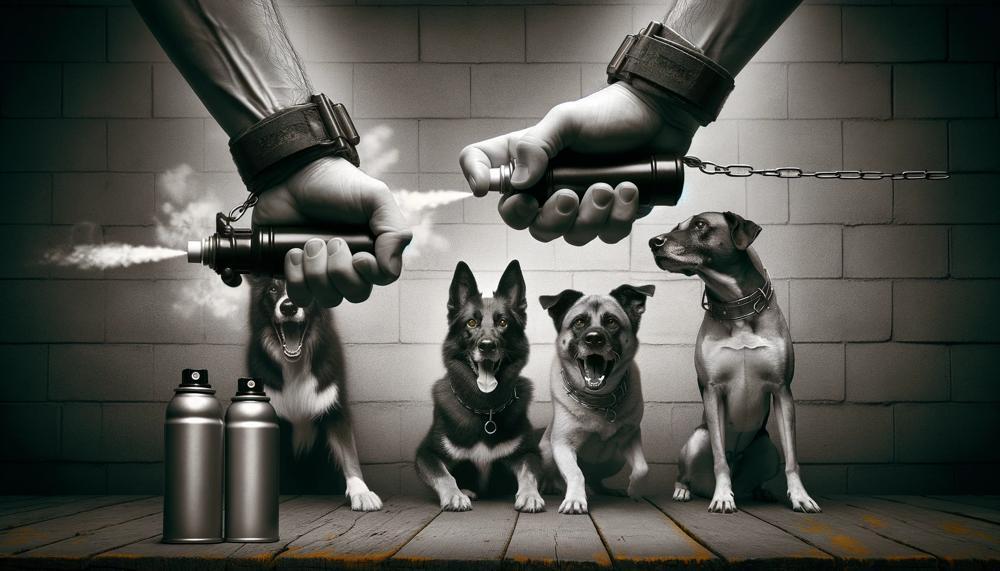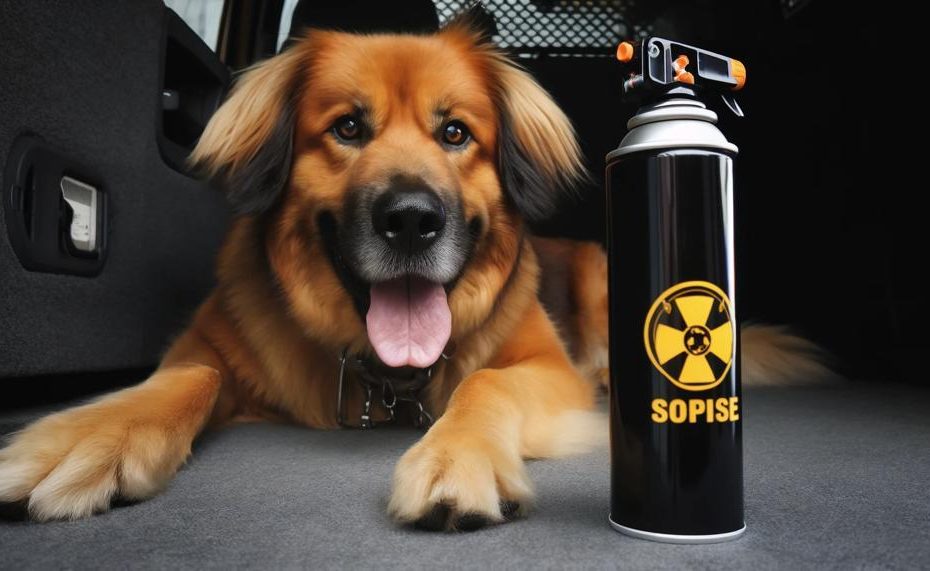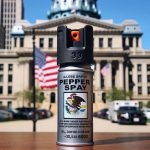Do you know that about 4 out of 5 dog owners don’t know that pepper spray can be bad for their animal friends? People who talk about pet safety and self-defense often forget about an important problem that this shocking number brings to light.
Even if you’re bringing pepper spray for your own safety, it’s important to know what it can do to dogs, who could end up being the target.

This blog post will go into great detail about how pepper spray affects dogs, ranging from the short-term effects on their bodies to the longer-term health effects.
So, what happens if you pepper spray a dog?
Pepper spray can cause intense discomfort in dogs, including temporary blindness, respiratory distress, and a burning sensation. The active component, OC (Oleoresin Capsicum), affects the sensitive membranes of a dog’s eyes, nose, and throat. This leads to intense irritation, burning, and pain, causing temporary blindness, difficulty breathing, and disorientation. The dog may also experience excessive drooling as a result of the irritation.
However, even if the spray is painful and will incapacitate the dog for several hours, in the long run, the spray will not cause any health damage to the sprayed dog3. There are certain products that may also have a repelling effect from a considerable distance (e.g. 10 to 20 feet). The amount of pepper in the spray is very low.
Let’s unpack this complex issue together, ensuring our four-legged friends stay safe and healthy.
Contents
Why Do People Use Pepper Sprays on Dogs?
Pepper spray, often referred to as OC spray, serves as a defense mechanism against aggressive canine encounters. Here’s a closer look at why individuals might resort to using pepper spray on dogs and its efficacy as a self-defense tool.
Reasons for Using Pepper Spray on Dogs:
- Self-Defense Against Attacks: In situations where a dog behaves aggressively and poses a threat to a person, pepper spray can be used to incapacitate the dog temporarily, allowing the person to escape harm.
- Non-Lethal Deterrent: Compared to other defensive measures which could be lethal, pepper spray provides a non-lethal alternative to prevent a dog attack.
- Legal and Accessible: It is legal in most regions to use pepper spray for self-defense, making it a widely accessible option for many individuals concerned about personal safety.
Effectiveness of Pepper Spray:
| Aspect | Effectiveness | Details |
| Immediate Impact | High | Causes intense irritation to eyes, nose, and throat; temporarily incapacitates the dog. |
| Use Case | Conditional | Most effective when used as a last resort and aimed accurately at the attacking dog. |
| Safety | Variable | Safe for use if handled correctly, yet risks misapplication or blowback which can affect the user. |
Cautions and Alternatives:
While pepper spray can be a viable option for self-defense against dogs, it should only be used when absolutely necessary and with caution. Misuse can lead to serious consequences for both the dog and the user, including long-term health effects for the dog and legal ramifications for the user.
Alternatives such as citronella sprays, air horns, and distraction techniques can also be effective in deterring an aggressive dog without resorting to harsh measures.
How Effective Is a Pepper Spray on Dogs?
When confronted by an aggressive dog, your heart races, palms sweat, and fear sets in.
In these dire straits, pepper spray emerges as a beacon of hope. But, just how effective is this fiery aerosol against our canine counterparts?
| Aspect | Details | Implications |
| Active Ingredient | Oleoresin Capsicum (OC) | Causes intense irritation and temporary blindness, effective for deterring aggressive dogs. |
| Spray Range | 6-12 feet optimal | Ensures a safe distance from the threat. |
| Types | Stream, mist, foam | Choice depends on the situation and user’s preference. Stream is more precise, mist covers a wider area. |
| Regulations | Varies by location | Always check local laws before carrying or using pepper spray. |
| Expiration | Can expire | Regular checks and replacement necessary to maintain efficacy. |
Things You Need to Know Before Using a Pepper Spray
To safeguard both yourself and the dog, adhering to specific safety measures before employing pepper spray is crucial. Here’s a succinct breakdown:
| Precaution | Details | Reason |
|---|---|---|
| Understand its use | Grasp the purpose behind using pepper spray as a deterrent. | To ensure it’s used ethically and as a last resort. |
| Know your spray | Identify the spray type suited for canines, focusing on range and intensity. | Different formulations are designed for varied situations. |
| Legal awareness | Review local laws on using pepper spray on animals. | To avoid legal repercussions. |
| Usage mastery | Practice aiming and understand the impact of wind direction. | Increases the chance of deterring the dog without harm. |
| Safety storage | Keep out of reach of children and secure in a designated spot. | Prevents accidental discharge or misuse. |
| Post-use actions | Seek medical help for the dog and report the incident. | Ensures responsible use and care for the animal’s wellbeing. |
| Choose quality | Select a reputable brand with positive feedback. | Reliability and effectiveness are paramount. |
Conclusion
The tricky balance between protecting people’s well-being and making sure animals are safe is like walking a line. People often use pepper spray for self-defense, especially when a violent dog becomes a danger. The chemical, which contains Oleoresin Capsicum (OC), acts as a hot enemy, making the dog feel sick and confused and providing people with a crucial escape window.
It is impossible to deny pepper spray’s power; it temporarily blinds and confuses animals that it hits. There are some problems with this chemical shield, though. How well the tool works depends on how close, precise, and windy the surroundings are. Unintentionally exposing or upsetting someone can occur due to a slip-up or poor guess.
When people talk about using pepper spray, the conversation doesn’t end with a sharp criticism. The topic of discussion includes law and moral issues, with a focus on how important it is to know and follow the limits of their use. This story encourages us to think about nonviolent options that can keep us safe without the harsh pain of consequences. It calls for a balance in which safety is not sacrificed for kindness.





